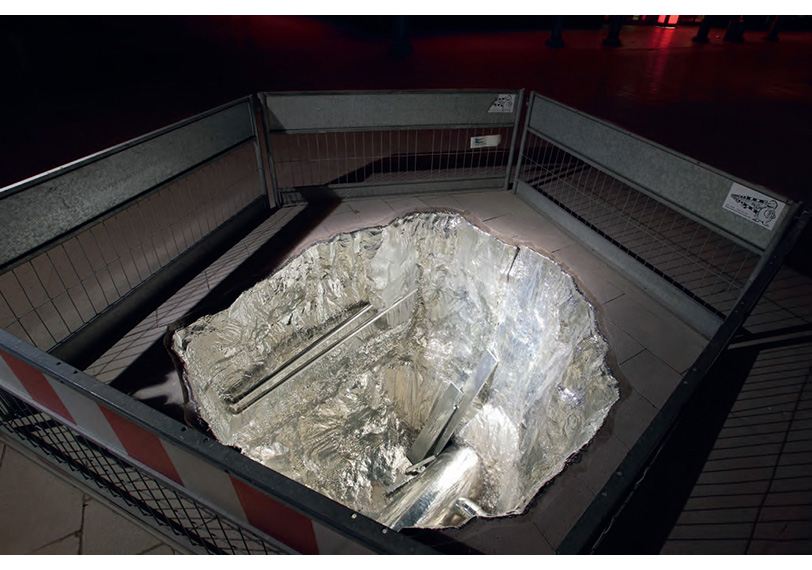Shining Void
2020. Installation im öffentlichen Raum / Installation in public space.
Es wurde lange gebaut in Hamburg-Wandsbek. Gerade hat man die neu gestaltete Zone um den Wandsbeker Markt den Passanten übergeben.
Die Menschen können nun auf dem gepflasterten ‚Boulevard‘ flanieren und einkaufen. Nun das: schon wieder eine Baustelle? Das frisch verlegte Pflaster unter einer Straßenlaterne gleich hinter dem U-Bahn-Ausgang ist aufgebrochen. Hüfthohe rot-weiße Absperrzäune markieren eine neue Baugrube und behindern den schnellen Laufweg aus der U-Bahn-Station Wandsbek Markt.
Aus der Tiefe scheint es zu leuchten – neugierig tritt man näher. Die Wände des Loches im Boden sind mit einer spiegelnden Hochglanzchromschicht ausgekleidet, die die Öffnung samt ihrer freigelegten Versorgungsleitungen und Kanalrohre abformt. Das Chrom wurde über alle Materialien – Erde, Stein, Betonrohre und Leitungen –, gezogen und endet präzise an den Rändern der Gehwegplatten. Statt auf braune Erde blickt man drei Meter tief auf silbrig glänzenden Grund und Oberflächen, die das Tageslicht in seiner jeweiligen Farbe sowie den unmittelbaren Umraum reflektieren und ihn somit zum Bestandteil des Loches machen. Nachts erstrahlt die Grube durch einen zurückhaltend platzierten Punktstrahler in gleißendem Licht.
Die Aushöhlung ist in ihrer futuristisch anmutenden Materialität etwas Fremdes, das sich gleichsam in den Stadtkörper eingeschmolzen hat. Zugleich konserviert und veredelt das Silber, ähnlich wie bei einer medizinischen Behandlung von Entzündungen, die ‚Verletzung‘ des soliden Grundes.
Die Installation formt ein ‚Highlight‘ in unspektakulärer Lage am Straßenrand, das unterhalb des Bodenniveaus erst entdeckt werden muss. Die Silbergrube erinnert so an einen märchenhaften Schatz und damit verbunden an die Hoffnung der alten und neuen ‚Goldgräber‘ Wandsbeks auf Prosperität und Aufbruch in einem ehedem randständigen Viertel Hamburgs, das in weiten Teilen während des Zweiten Weltkriegs zerstört worden war.
Demgegenüber suggeriert das Glanzstück aufgrund seines Formeninventars Funktionalität und lässt die Passanten über mögliche Zwecke rätseln. Warum wird hier in dieser Form gebaut? Was befindet sich unter unseren Füßen und wie ist es organisiert? Die Inszenierung regt Zaungespräche an: shining void wird zum Treff- und Haltepunkt für die Passanten.
Construction work has been going on for some time now in Hamburg-Wandsbek. The newly completed area around the Wandsbek market place has just been opened up again to the public. People can once more stroll and shop along the paved ‘boulevard’. Now this: not another construction site?
The newly laid pavement under the street light right behind the underground train exit has been opened up once more. Waisthigh red and white barriers mark a new excavation pit and hinder a speedy exit from the underground station Wandsbek.
The hole seems to radiate light—being curious, people step nearer to have a closer look. The walls of the pit have been lined with a layer of high-gloss chrome, its revealed service pipes and sewage pipes moulded to the form of the opening. The chrome covers everything—earth, stone, concrete pipes and cables—and ends precisely at the upper edge of the paving stones. Instead of looking down on brown earth, one looks down into a shiny, silver void with surfaces that reflect daylight in all its colours and the near surroundings making them part of the hole. At night the opening glistens using an unobtrusively placed spotlight.
The excavation with its apparently futuristic surface is something foreign that has quasi fused with the town itself. At the same time the silver conserves and refines the ‘damage’ to the solid ground, similar to the medical treatment of an inflammation.
The installation creates a ‘highlight’ that first has to be discovered under ground level in an unspectacular place at the side of the road. The silver hole reminds us of treasure found in fairy tales and the hope of Wandbek’s old and new ‘gold diggers’ for prosperity and the beginning of a new era in the former Hamburg suburb that was extensively damaged during World War Two.
On the other hand, because of its contents, this highlighted place suggests some kind of function and causes people to puzzle over its possible purpose. What is being built here in this way? What is under our feet and how is it being organised? The scene encourages conversation: shining void becomes a meeting place and stopping place for the passers-by.




